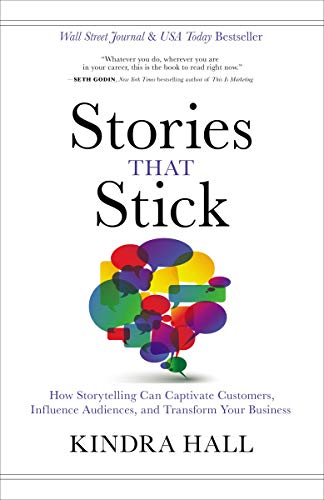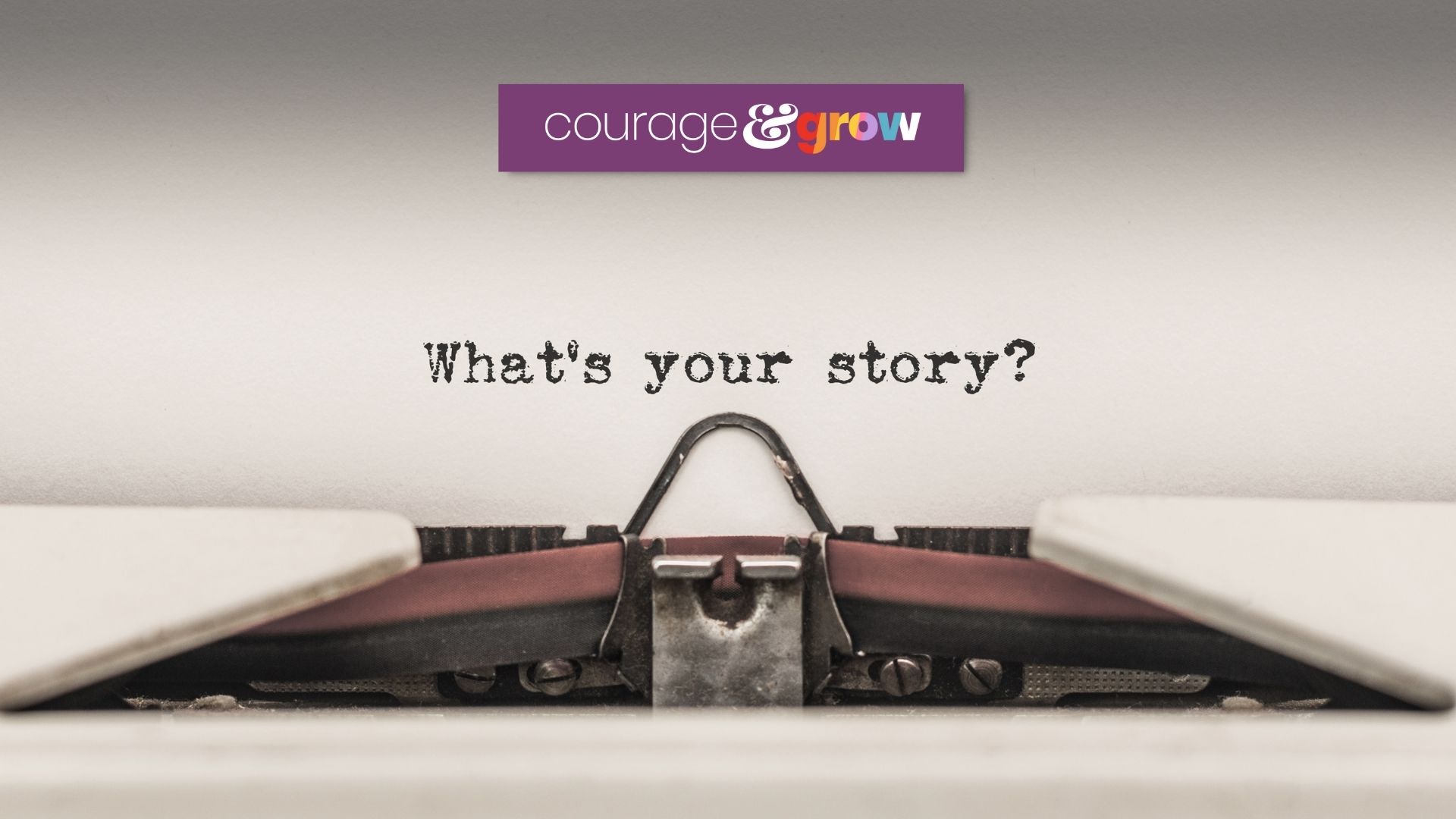At a glance
Quick summary
- Two books: I share two of my favorite storytelling for business books!
- Framework: We cover the format every successful story follows
- Components: I share four key ingredients that make a story great
- Devices: We also discuss six devices you can use to heighten the stakes of your story
Two incredible books I recommend you read
If you’re in business, and you’re interested in storytelling for business, there are two indispensable books that I recommend you read.
The first is Stories That Stick by Kindra Hall

The second is Storyworthy by Matthew Dicks

Note
Storyworthy isn’t specifically a business book. But, it’s an incredible read and the lessons apply to business!
These books are the sources for much of the information throughout this article. They’ve also provided insights that I use throughout my life as well.
I highly, highly, highly recommend them!
Why even bother with storytelling for business?
When your audience connects to you, your brand, your business, etc. on an emotional level, they’ll go out of their way to continue working with you.
In Stories That Stick, Kindra Hall argues (and I agree) that storytelling is the way to connect to your potential buyers.
No matter the scenario. No matter the gap. No matter the product or the audience. The easiest, most effective way to build bridges that capture attention, influence behavior, and transform those who cross them, resulting in gaps that stay closed and bridges that last, is with storytelling. In the end, stories are what stick.
Kindra Hall, Stories That Stick
13 techniques you can use to improve your storytelling for business
Below, you’ll find 13 dead-useful storytelling techniques.
They’re broken into three groups: Framework, Components, and Devices
Framework
Each successful story follows the Normal → Five-second Moment → New Normal framework.
1. Normal
The way things are before something changed.
- Audiences care about and invest in stories that start with the Normal
- You need to spend time setting up the way things were before things changed
- You use the Normal to establish the components (more on these in the next section)
- Stories that fall
Examples
- Most stories on the news. We don’t personally connect to these because they start in the middle, rather than developing the Normal first
- A marketer struggling to do their job
- A vet unable to help pets whose owners can’t pay
2. Five-second moment
A moment when something fundamentally changes forever.
- No matter the length of the story, every story is about a five-second moment in someone’s life. The rest of the story is only there to support and heighten that Moment.
- Kindra Hall calls this the explosion. Personally, I hate that term. I greatly prefer Matthew Dicks’ Five-second Moment.
- Both Hall and Dicks argue that the Five-second Moments are the most important part of a story. Without this ‘explosion’, you have no story, and no reason for people to care about what you’re saying.
Examples
- Discovering / using a new product or service
- The moment you learn something new
- Your beloved pet passes away
3. New normal
What life is like now, after the five-second moment.
- What do you know now? How are you stronger or wiser?
- How do you feel after the Five-second Moment?
- What do you want your audience to feel after the Five-second Moment?
Examples
- A marketer whose job is so much easier now
- A vet who can help any pet by offering a payment plan
- Starting a photography business to help pet parents capture special moments with their pets
Components
Each story should have these four components.
4. Identifiable character
A single, or several single, separate characters we can identify with and connect to.
- The Character is not a hero. It’s not a company name, or a value, or a group of people.
- It’s a real person.
Examples
- You
- A student
- A parent
- A colleague
- A client
- A customer
- A friend
- A stranger
5. Authentic emotion
Emotion(s) felt by the characters in the story.
- They don’t have to be dramatic or major
- Matthew Dicks argues that the best Five-second Moments are small, ordinary happenings that lots of folks can understand and connect with
- Your job is to describe what the Character feels, and then that will bring the audience along
Examples
- Frustration
- Fear
- Wonder
- Curiosity
- Connection
- Hope
- Belonging
6. Significant moment
A specific point in time and/or physical space.
- This is Kindra Hall’s version of a Five-second Moment
- When you paint this Moment in your story, your audience should be able to see the place in their minds
Examples
- Kids eating lunch together in a school cafeteria
- Studying at a table in a Starbucks
- Waiting in a vet’s office waiting room
7. Specific details
The use of specific, descriptive, and sometimes unexpected details and imagery.
- Details draw the audience into a world that feels familiar to their own
- The finer, more specific the detail, the better!
- Don’t fall into the trap of trying to keep things as brief as possible, and therefore eliminate all of the details. Brevity isn’t necessarily what you’re after! If the story is compelling, your audience will stick with it.
Examples
- For a story in the 1980s: A boombox
- For a story for parents: Wrestling a stroller into the trunk of a car
- For a story for parents: Your kids’ faces pressed against the bus window as they leave for school the first time
Devices
In Storyworthy, Matthew Dicks provides six devices you can use to raise the stakes of your story.
Why would you want to raise the stakes?
Because stakes are the reason your audience will want to listen to the story.
“Stakes are the Nazis and the snakes in Raiders of the Lost Ark. Darth Vader and his storm troopers in Star Wars. The iceberg in Titanic. The dinosaurs of Jurassic Park.”
Pro Tip
You don’t have to use all six strategies in every story! Use as many as makes sense for your story.
An example we’ll use throughout
To illustrate each device, we’ll use this fictitious story idea for a pet photographer:
I loved my dog Molly, and I took lots of photos of her. But, when Molly passed away unexpectedly, I was heartbroken to discover that I had no photos of us together. Since then, I’ve made it my mission to capture memories of pets with their parents so they’ll have memories to cherish forever.
8. Elephant
The thing that everyone can see; a clear explanation of what to expect.
- Every story must have an Elephant
- It’s a ‘clear statement of the need, the want, the problem, the peril, or the mystery’ (Storyworthy).
- It should come as early in the story as possible
- From a business standpoint, the Elephant is the problem your product or service is solving
Example
Molly passing away unexpectedly and the storyteller realizing she had no photos of them together
9. Backpack
Increasing the stakes of a story by increasing the audience’s anticipation about an upcoming event.
- A Backpack makes the audience wonder what will happen next
- One way to accomplish this is to share a plan
- Often, the best plans to share are those that don’t work out
Example
The storyteller took lots of photos of Molly, but never thought to have someone capture photos of the two of them together
10. Breadcrumbs
Hinting at a future event, but only revealing enough to keep the audience guessing.
- Choose Breadcrumbs that ‘create the most wonder in the minds of your audience without giving them enough to guess correctly.’
- Breadcrumbs are best when the ‘truly unexpected’ is coming
Example
The storyteller got a postcard in the mail reminding her that it was time for Molly’s annual checkup
11. Hourglass
Deliberately dragging out the story as you approach the payoff.
- ‘When you know your audience is hanging on your every word, let them hang.’
- When you approach the payoff, slow things down. ‘Grind them to a halt when possible.’
- ‘Find the moment in your story that everyone has been waiting for, then flip that Hourglass and let the sand run.’
Example
Adding in details, emotions, and imagery prior to letting the audience know that Molly didn’t make it
12. Crystal ball
A false prediction made by the storyteller to cause the audience to wonder if the prediction will come true.
- As humans, we spend lots of time predicting, trying to anticipate what comes next
- ‘Deploy Crystal Balls strategically: Only when your prediction seems possible.’
Example
The storyteller scheduled Molly for a routine checkup at the vet, and she and Molly were looking forward to seeing her vet again!
13. Humor
Being funny in your story.
- Humor doesn’t actually raise the stakes!
- Humor helps keep your audience’s attention, especially in spots where your story might be less than compelling.
Example
Sharing the time Molly ran down a dock, misjudged how long it’d take to stop, and skidded off into the water.
Use your Business Core Values to help craft your stories
If you’re storytelling for business, it’s helpful to have your Core Values nailed down. These can guide both the finding and crafting of your stories!
Check out my post, A step-by-step way to identify your top 5 Business Core Values, for more.
Others? Questions?
Any thoughts or questions on storytelling for business? Anything with which you disagree? Anything I missed?
Leave a comment below and let me know!
Is the Pet Photography example speaking to you?
While the examples I used throughout this post were fictitious, they’re based on a real business!
Check out Firefly Pet Photography!





0 Comments